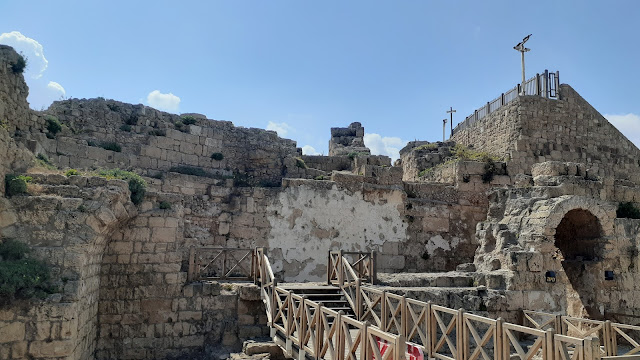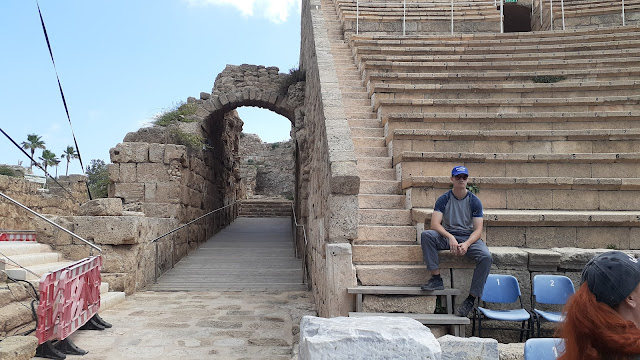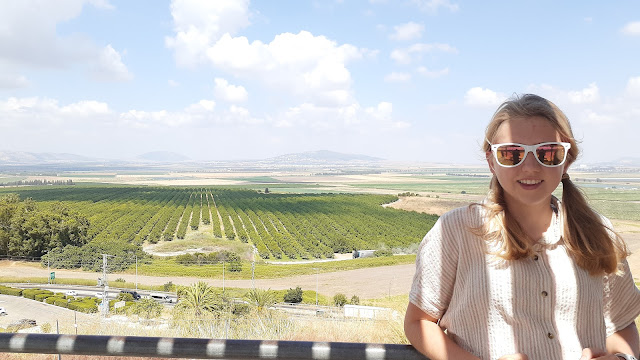After we crossed the Jordanian/Israeli border, we drove to our hotel in Tel-Aviv. It was just a few blocks away from the Mediterranean Sea and we wanted to check it out. Ashlyn wanted to skip the next day and join the beach volleyball games down below, but our schedule was too busy for a rest day.
Our first sightseeing day in Israel began in Joppa (aka Jaffa), one of the oldest port cities in the world. Just a half mile away from Tel-Aviv, the two cities joined as they grew and it's now known as Tel-Aviv-Jaffa. In Joppa, several major events happened that you can find in the Bible. In the Old Testament, this is where Jonas fled, went out to sea on a boat, and was swallowed by a whale. (Jonah 1:3) Then in the New Testament, Peter raised Tabitha from the dead. (Acts 9:36). While in Joppa, Peter stayed in the home of a tanner named Simon (Acts 9:43). That home is under the church you can see on the right of this picture (it's a rocky square structure 2 buildings behind the white truck).
After Joppa, we drove north up the Mediterranean coastline to a town called Caesarea Maritime. There were several towns in Israel names after Caesar, so it's important to keep "Maritime" after it. This was aptly named because of the coast.
Here, King Herod had his main royal palace. His ruins are still being excavated, but you can see below the theater.
A closer look from the side entrance (lower levels) where VIPs back in the day would enter.
This theater is still used today by locals, alhtough they had to reinforce rows 3 and above. The lowest rows 1 & 2 are still original (where Luke is sitting).
King Herod also had an outdoor arena for competitions. His palace was the center piece of the town where people of high social class wanted to be seen.
During their excavations, they found this stone which provided archelolgical proof that Pontius Pilate lived during this time and had a leadership role within Roman authority.
These are the ruins of his personal residence. In the far distance is a large, olympic-size fresh water pool. The pool was fed from an aqueduct built to transport water from Mount Carmel. In the foreground you can see that the flooring used to be beautiful mosaics. There's another courtyard to the right (not in the picture) where St. Paul defended himself before his final journey to Rome to appeal his case to Caesar (Acts 25).
We then left the coastline and drove inland up to Mount Carmel. At the highest point in Mount Carmel, Elijah defeated the false prophet ba'al. From this vantage point, you can see the Jezerel Valley which has the most fertile land in Israel.
The Jezerel Valley was the main trade route from Egypt to Babylon in 4000BC. This valley was protected and controlled by a small village called Megiddo that was built on top of a hill. As we walked up the hill, the kids decided to have some fun.
Those ruins are still intact, and it was incredible to see how they lived and obtained fresh water for their community.
The walls separated the common areas from the housing units.This valley near Mediggo is prophesied to be the site of Armageddon, or where the gathering of armies for the end of times will take place.
We then drove up north out of the valley and into the region of Galilee to the town of Nazareth. Nazareth was a very poor town on a mountain top that got very cold in the winter. About 40-50 families lived here in Jesus' time, and they lived underground in caves to stay warm. Below is a view from inside the Church of the Annunciation. It's where Mary lived as a girl (Luke 1:26), where the Angel Gabriel appeared to Mary, and where Jesus was raised for 27 years after they returned from Egypt. You can see three different churches build over the cave, as each time one structure was destroyed, another would be built over it. It's been excavated back to the original structure (or what's left of it).
A closer view of the cave. You can see the stairs coming down that the Holy Family must have walked thousands of times.Still in Nazareth, but at the edge of the town, there's a cliff where Jesus was attempted to be thrown down but walked back through the crowd (Luke 4:29). “Truly I tell you, no prophet is accepted in his hometown." Below is that cliff called Mount Precipice.















